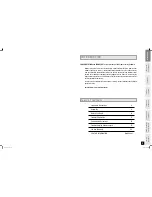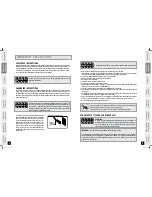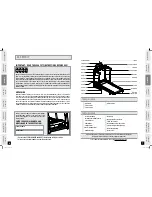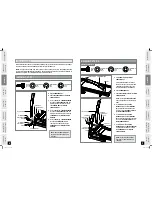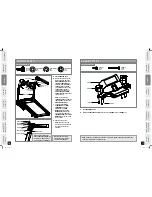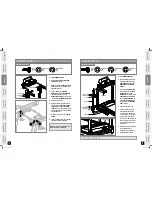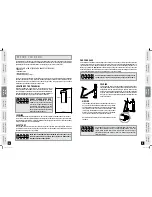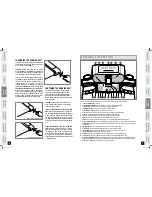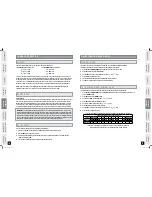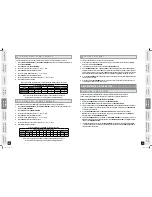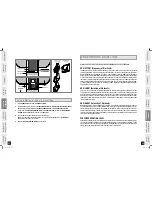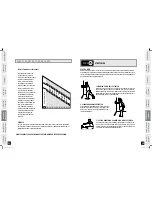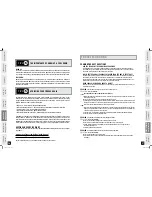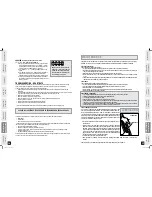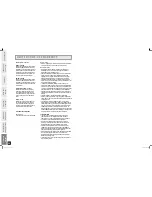
2
INTR
ODUC
TION
IMPOR
TANT
PRE
CA
UTIONS
BEF
ORE
YOU
BE
GIN
TREADMILL
OPER
ATION
LIMITED
W
ARR
ANTY
TR
OUBLE
SHOO
TING
&
MAINTENANCE
CONDITIONING
GUIDELINE
S
AS
SEMBL
Y
BEF
ORE
YOU
BE
GIN
AS
SEMBL
Y
2
INTR
ODUC
TION
IMPOR
TANT
PRE
CA
UTIONS
TREADMILL OPER
ATION
CONDITIONING GUIDELINE
S
TR
OUBLE
SHOO
TING
&
MAINTENANCE
LIMITED
W
ARR
ANTY
WARM UP
The first 2 to 5 minutes of a workout should be devoted to warming up. The warm-up will limber your
muscles and prepare them for more strenuous exercise. Make sure that you warm-up on your product
at a slow pace. The warm up should gradually bring your heart rate into your Target Heart Rate Zone.
COOL DOWN
Never stop exercising suddenly! A cool-down period of 3-5 minutes allows your heart to readjust to
the decreased demand. Make sure that your cool down period consists of a very slow pace to allow
your heart rate to lower. After the cool-down, repeat the stretching exercises listed above to loosen
and relax your muscles.
An important step in developing a long term fitness program is to determine your goals. Is your
primary goal for exercising to lose weight? Improve muscle? Reduce stress? Prepare for the spring
racing schedule? Knowing what your goals are will help you develop a more successful exercise
program. Below are some common exercise goals:
• Weight Loss - lower intensity, longer duration workouts
• Improve Body Shape and Tone - interval workouts, alternate between hi and low intensities
• Increased Energy Level - more frequent daily workouts
• Improved Sports Performance - high intensity workouts
• Improved Cardiovascular Endurance - moderate intensity, longer duration workouts
If possible try to define your personal goals in precise, measurable terms, and then put your goals in
writing. The more specific you can be, the easier it will be to track your progress. If your goals are
long term, divide them up into monthly and weekly segments. Longer term goals can lose some of the
immediate motivation benefits. Short term goals are easier to achieve. Your console provides you with
several readouts that can be used to record your progress. You can track Distance, Calories or Time.
KEEPING AN ExERCISE DIARY
To make your personal exercise log book, print the weekly and monthly log sheets off of your computer
by going to:
www.horizonfitness.com/guides/weeklylog.pdf
www.horizonfitness.com/guides/monthlylog.pdf
As your fitness improves, you can look back and see how far you’ve come!
THE IMPORTANCE OF WARM UP & COOL DOWN
ACHIEVING YOUR FITNESS GOALS
TIPS
TIPS
COMMON PRODUCT QUESTIONS
ARE THE SOUNDS MY TREADMILL MAKES NORMAL?
All treadmills make a certain type of thumping noise due to the belt riding over the rollers, especially
new treadmills. This noise will diminish over time, although may not totally go away. Over time, the belt
will stretch, causing the belt to ride smoother over the rollers.
WHY IS THE TREADMILL I PURCHASED LOUDER THAN THE ONE AT THE STORE?
All fitness products seem quieter in a large store showroom because there is generally more background
noise than in your home. Also, there will be less reverberation on a carpeted concrete floor than on a
wood overlay floor. Sometimes a heavy rubber mat will help reduce reverberation through the floor. If a
fitness product is placed close to a wall, there will be more reflected noise.
WHEN SHOULD I BE WORRIED ABOUT A NOISE?
As long as the sounds your treadmill makes are no louder than a normal conversational tone of voice, it is
considered normal noise.
PROBLEM:
The console does not light up and/or the belt does not move.
SOLUTION:
Verify the following:
DOES THE RED LIGHT ON THE ON/OFF SWITCH LIGHT UP?
IF YES:
• Double check that all connections are secure, especially the console cable. Unplug and reconnect the
console cable to verify.
• Make sure the console cable is not pinched or damaged in any way.
• Turn the power off, unplug the power cable and wait 60 seconds. Remove motor cover. Wait until all red
LED lights have gone off on the motor control board before proceeding. Next, verify that none of the
wires connected to the lower board are loose or disconnected.
IF NO:
• Verify that the outlet the machine is plugged into is functional. Double check that the breaker has not
tripped, it is on a dedicated 20-amp circuit, it is not on a GFCI-equipped outlet, and it is not plugged into
a power strip/surge protector or extension cord.
• The power cord is not pinched or damaged and is properly plugged into the outlet AND the machine.
• The power switch is turned to the ON position.
PROBLEM:
The treadmill circuit breaker trips during a workout.
SOLUTION:
Verify the following:
• Make sure the treadmill is plugged into a dedicated 20-amp circuit.
• Verify that you do not have the machine on an extension cord or surge protector.
• Confirm that the machine is not plugged into a GFCI-equipped outlet or on a circuit that has a
GFCI-equipped outlet on it.
• Lubricate treadmill deck if necessary.
PROBLEM:
The running belt does not stay centered during a workout.
SOLUTION:
Verify the following:
• Make sure the treadmill is on a level surface.
• Verify that the belt is properly tightened and centered (Refer to the Adjustment section for detailed
directions).
TROUBLESHOOTING
T1201_Rev.1.7.indd 26-27
7/31/08 4:52:56 PM


